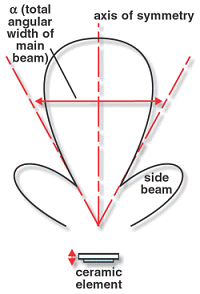Ultrasonic Air Transducers
Piezoelectric high frequency transducers generate, receive, or generate and receive ultrasonic signals that can be used to measure distances in air, water, or other fluid media, to determine flow rates, or for other applications. A single ultrasonic transducer can both generate and receive a signal, but the two functions often are separated to optimize the performance of each task.
Apparatus in which piezoelectric high frequency transducers are used to measure distances in air -- impulse-echo devices -- include level detectors for large containers (e.g., grain silos), proximity-warning devices (parking aids), and intruder alarms. The operating range for an impulse-echo device is determined by the operating frequency and the power of the ultrasonic transducer. The latter factor, power output, is a function of the mechanical characteristics and thermal constraints of the device. Operating frequency requires careful consideration because signal reflection and absorption are frequency dependent. For long range applications, low frequency signals are subject to much less signal damping than high frequency signals. For the best signal directivity and object resolution, however, the frequency should be as high as possible. For accurate distance measurements, especially at short distances, the excitation pulses must be short.
The range of an impulse-echo device can be extended by narrowing the bandwidth. A narrow bandwidth also reduces the input power requirement, and minimizes interference and reflections from objects outside the signal path. If the signal is too narrow, however, atmospheric conditions can divert the signal from its intended path, particularly at longer distances. Also, a broader band will exhibit less noise.
The mechanical resonance frequency of a flexional ultrasonic transducer is a function of the characteristics of the piezoelectric ceramic element, the thickness and diameter of the metal diaphragm, the manner in which the ceramic / metal flexional unit is mounted, and the manner in which the transducer is incited to vibrate.
Directivity of a flexional ultrasonic transducer (see figure) depends on the wavelength of the emitted signal in air (λ), the diameter of the area radiating the signal (D), and the uniformity of the vibrations across the surface of the ceramic element. As λ is decreased, or D is increased, the angle of the beam narrows. Directivity is sharpened and the range is lengthened. Alternatively, if λ is increased or D is decreased, to the extent that λ equals or exceeds D, the directional characteristic assumes an undesirable spherical form.
In echo sounding applications in which a single, electronically switched ultrasonic transducer serves both as transmitter and as receiver, vibrations established during signal transmission must subside before the piezoelectric transducer can differentiate a returning signal from background, so there must be at least a minimum distance between the transducer and the object. The excitation impulse of the ultrasonic signal should be as short as practical, which dictates the use of a wide bandwidth and a high operating frequency. A high operating frequency, in turn, means the high frequency transducer can be smaller. On the other hand, for a given distance, signal damping increases significantly as the signal frequency increases. The maximum range can be increased, and small objects can be detected more easily, by narrowing the signal beam.



